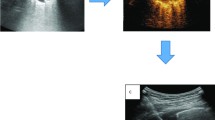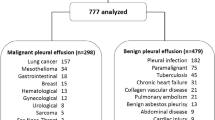Abstract
To explore the diagnostic value of deep learning convolutional neural network (CNN)-based computed tomography (CT) scan in tumor disease images, clinical factors related to serous effusion were analyzed. The relevant case data of 224 patients with serosal effusion caused by malignant tumor treated in X Hospital from October 1 to February 2017 were selected, so did the positron emission tomography (PET) image data based on deep learning CNN. Then, the causes and diagnosis of PET effusion in each group were analyzed, and multi-factor analysis was performed on the effusion in the pleural cavity, abdominal cavity, pericardial cavity, and no effusion group. It was found through PET scan under deep learning CNN algorithm that the location of the effusion was related to the primary lesions. The malignant pleural effusion (72 cases) and pericardial effusion (19 cases) both occurred mostly in lung cancer, and the second was the digestive system tumor. The malignant peritoneal effusion concurrent lesions mainly occurred in the digestive system (18 cases of gastric cancer, 4 cases of colon cancer, 2 cases of rectal cancer, and 1 case of small intestine cancer). Malignant multiple serous cavity effusion (57 cases) mostly occurred in lung cancer (30 cases). From the analysis of clinical indicators of pulmonary infection, the infection rates of pericardial cavity (89.13%), abdominal cavity (82.3%), and thoracic cavity (83.78%) were higher in the group with effusion than in the group without effusion (65.23%), and there was a statistical difference (*P < 0.05). The total detection rate, sensitivity, specificity, and accuracy of PET scan under deep learning CNN were 82.61%, 93.24%, 76.47%, and 92.41%, respectively. In summary, PET-CT images based on deep learning CNN were of important diagnostic value for chest, ascites, pericardial effusion, and serous cavity effusion of unknown reasons. In addition, lung infection in tumor patients was an important factor aggravating serous effusion.







Similar content being viewed by others
Explore related subjects
Discover the latest articles, news and stories from top researchers in related subjects.References
Jones RM, VandenBussche CJ (2020) Alveolar rhabdomyosarcomas involving serous cavity fluid specimens exhibit diverse cytomorphologies: a case report and review of the literature. Diagn Cytopathol 48(11):1155–1161
Xing LY, Yin J, Shao M et al (2018) Clinical characteristics and prognosis of serous body cavity effusions in patients with sepsis: a retrospective observational study. BMC Anesthesiol 18(1):169
Yang MF, Tong ZH, Wang Z et al (2019) Development and validation of the PET-CT score for diagnosis of malignant pleural effusion. Eur J Nucl Med Mol Imaging 46(7):1457–1467
Han P, Yao R, Zhai D et al (2017) A case report of lung adenocarcinoma with polyserous effusions as the onset symptom. Medicine 96(36):7867
Sun J, Ding S, Zhu L et al (2020) Improving performance of recently introduced flow cytometry-based approach of malignant cell screening in serous cavity effusion. Int J Lab Hematol 42(5):612–618
Ferreiro L, Toubes ME, San J et al (2020) Advances in pleural effusion diagnostics. Expert Rev Respir Med 14(1):51–66
Xu W, Yu Q, Xie L et al (2017) Evaluation of Sysmex XN-1000 hematology analyzer for cell count and screening of malignant cells of serous cavity effusion. Medicine (Baltimore) 96(27):e7433
Dracham CB, Gupta S, Das CK et al (2019) Platinum sensitive cancer of ovary relapsed as pericardial effusion with cardiac tamponade. BMJ Case Rep CP 12(3):e228268
Öztürk S, Durmus G, Kalyoncuoğlu M et al (2017) Effusive constrictive pericarditis diagnosed with PET/CT and treated medically. Anadulu Kardiyol Derg AKD 8(6):12
Mahmutovic Persson I, Fransén Pettersson N, Liu J et al (2020) Longitudinal imaging using PET/CT with collagen-I PET-tracer and MRI for assessment of fibrotic and inflammatory lesions in a rat lung injury model. J Clin Med 9(11):3706
Li D, Zhang J, Ji N et al (2018) Combined 68Ga-NOTA-PRGD2 and 18F-FDG PET/CT can discriminate uncommon meningioma mimicking high-grade glioma. Clin Nucl Med 43(9):648–654
Gündoğan C, Yardimci AH, Güneş BY et al (2019) Subacute venous infarct mimicking cerebral metastasis in 18F-FDG PET/CT. Clin Nucl Med 44(2):e120–e122
Lv Z, Xiu W (2019) Interaction of edge-cloud computing based on SDN and NFV for next generation IoT. IEEE Internet Things J 7(7):5706–5712
Cao H, Liu H, Song E et al (2020) A two-stage convolutional neural networks for lung nodule detection. IEEE J Biomed Health Inform 24(7):2006–2015
Moitra D, Mandal RK (2019) Automated AJCC (7th edition) staging of non-small cell lung cancer (NSCLC) using deep convolutional neural network (CNN) and recurrent neural network (RNN). Health Inf Sci Syst 7(1):14
Schramm G, Rigie D, Vahle T et al (2021) Approximating anatomically-guided PET reconstruction in image space using a convolutional neural network. Neuroimage 224:117399
Song TA, Chowdhury SR, Yang F et al (2020) Super-resolution PET imaging using convolutional neural networks. IEEE Trans Comput Imaging 6:518–528
Gao X, Cai J (2017) Optimization analysis of urban function regional planning based on big data and gis technology. Bol Tec/Tech Bull 55(11):344–351
Porcel JM, Azzopardi M, Koegelenberg CF et al (2015) The diagnosis of pleural effusions. Expert Rev Respir Med 9(6):801–815
Guo C, Lu J, Tian Z, Guo W, Darvishan A (2019) Optimization of critical parameters of PEM fuel cell using TLBO-DE based on Elman neural network. Energy Convers Manag 183:149–158
Brunetti M, Panagopoulos I, Kostolomov I et al (2020) Mutation analysis and genomic imbalances of cells found in effusion fluids from patients with ovarian cancer. Oncol Lett 20(3):2273–2279
Kaul V, McCracken DJ, Rahman NM et al (2019) Contemporary approach to the diagnosis of malignant pleural effusion. Ann Am Thorac Soc 16(9):1099–1106
Senthil R, Nair AVR, Pratap T et al (2019) Isolated fluorodeoxyglucose avid right pleural deposits/effusion on an F-18 fluorodeoxyglucose positron emission tomography/computed tomography in patients with ovarian cancer—are they almost certainly metastatic? An extrapolation of atypical Meigs’ syndrome. Indian J Nucl Med 34(1):42–44
Rehman KA, Betancor J, Xu B et al (2017) Uremic pericarditis, pericardial effusion, and constrictive pericarditis in end-stage renal disease: insights and pathophysiology. Clin Cardiol 40(10):839–846
Saade A, Mansuet-Lupo A, Arrondeau J et al (2019) Pericardial effusion under nivolumab: case-reports and review of the literature. J Immunother Cancer 7(1):266
Author information
Authors and Affiliations
Corresponding author
Additional information
Publisher's Note
Springer Nature remains neutral with regard to jurisdictional claims in published maps and institutional affiliations.
Rights and permissions
About this article
Cite this article
Zhang, J., Zhang, Z., Ji, X. et al. Deep learning convolutional neural network in diagnosis of serous effusion in patients with malignant tumor by tomography. J Supercomput 78, 4449–4466 (2022). https://doi.org/10.1007/s11227-021-04051-5
Accepted:
Published:
Issue Date:
DOI: https://doi.org/10.1007/s11227-021-04051-5




